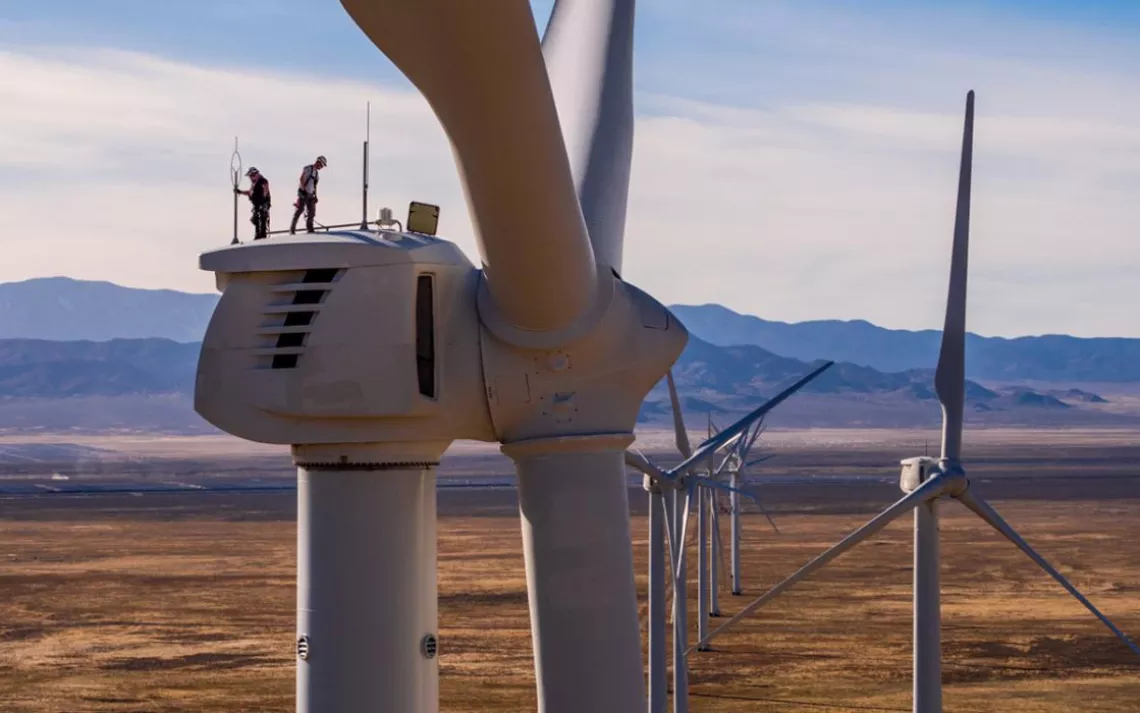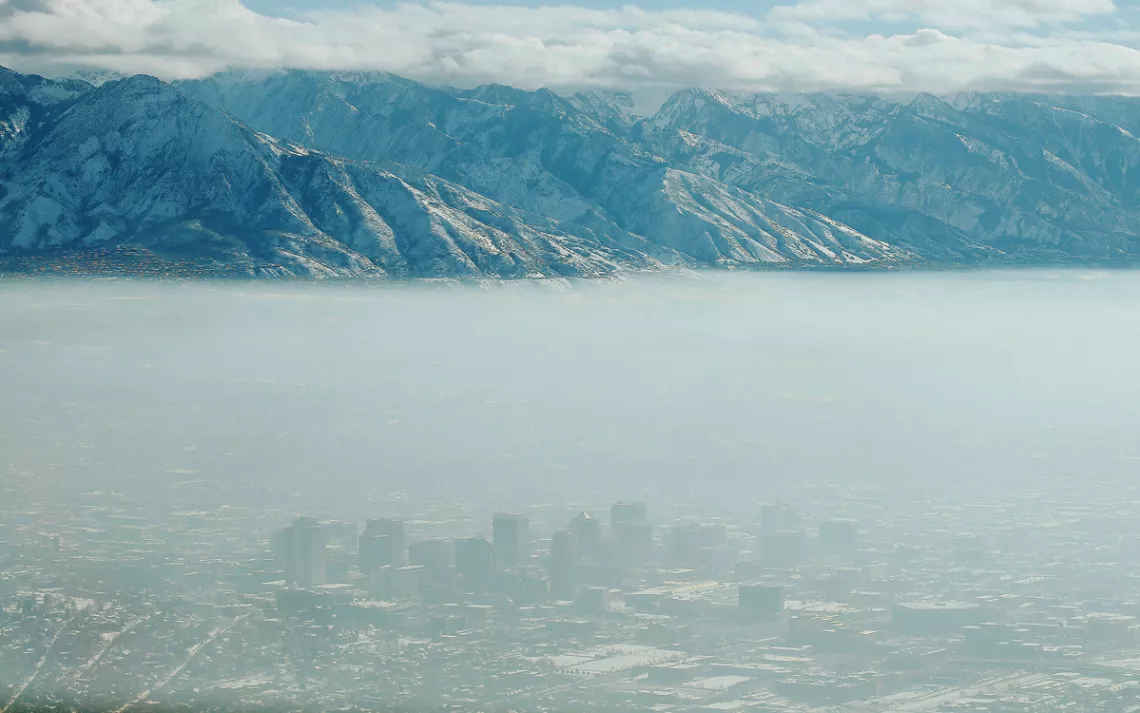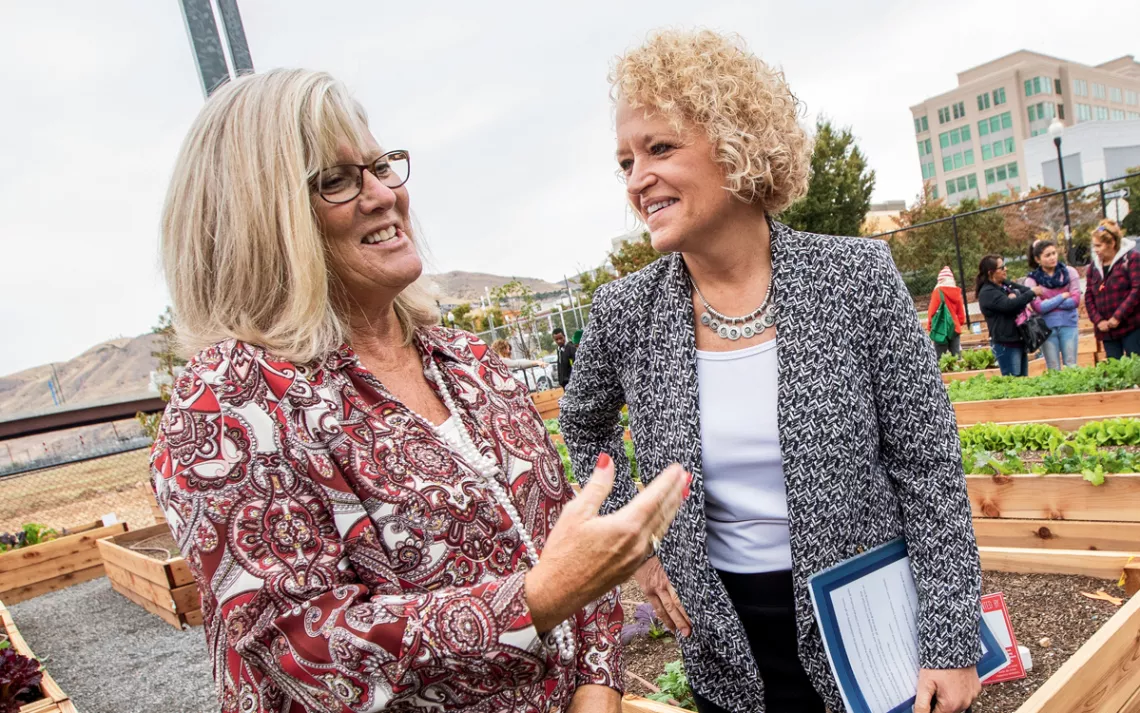The Utah Way to Achieving 100 Percent Clean Energy
How a politically conservative state set aggressive goals for clean energy

Utah's 306-megawatt Milford Wind Corridor wind farm spans Beaver and Millard Counties, delivering energy to Los Angeles, Burbank, and Pasadena in Southern California. | Photo by Douglas Barnes
IT'S IMPOSSIBLE TO VIEW the Salt Lake City skyline without noting six castle-like spires, at the top of which stands the golden statue of Angel Moroni blowing his horn. The famous towers of the Latter-day Saints temple rise in the city's midst, framed by the snowcapped Wasatch Range. To the west stand the three concrete stacks of the Gadsby power plant. Owned and operated by the state's dominant electric utility, Rocky Mountain Power, the plant once burned coal but switched to gas in the 1990s. Though most photographers crop images of the city to omit them, Gadsby's triple stacks are visible from almost any vantage point in the Salt Lake Valley—a seeming monument to the state's historic reliance on coal.
They also mark the place where Utah's carbon legacy may have come to an end.
In March 2016, Park City passed a resolution committing the city to transitioning 100 percent of its energy to renewable sources by 2032. Then in July 2016, Salt Lake City announced its own commitment. Moab, the redrock mecca, did the same at the beginning of 2017, followed later that year by Summit County. Soon after, Salt Lake suburbs such as Cottonwood Heights also joined in.

For years, Salt Lake City has struggled with fine-particle pollution, often in the form of winter smog. | Photo by Jeffrey D. Allred/Deseret News/AP
The commitments, which took the form of joint resolutions establishing community-wide goals for clean energy, transcended traditional political norms and reflected a growing understanding among the state's elected officials, environmental advocates, and industry and business leaders: They had no choice but to act on climate. The state is getting hotter, and snow is melting earlier, threatening not only the tourism and recreation industry on which many livelihoods depend but also the water supply.
Yet one very big puzzle still had to be solved. For these resolutions to succeed, cities needed the buy-in of Rocky Mountain Power—a state-regulated monopoly operated by PacifiCorp that for generations has been notorious for burning coal. Utah cities, except for a handful that produce their own power, are legally required to buy energy from the utility. Any Utah city that wanted to switch to renewable energy had two choices: start its own electric utility from scratch or convince the coal-reliant utility to join it.
At the end of 2016, representatives from Salt Lake City, Park City, and Summit County quietly organized a series of meetings at Rocky Mountain Power's Utah headquarters, near the Gadsby power plant, to discuss how cities committing to 100 percent renewable energy could achieve that goal in partnership with, rather than opposition to, the utility. They emerged last February with the HB 411 Community Renewable Energy Act—legislation that promises to provide any Utah city wanting to achieve net-zero emissions with a path for doing so by 2030. In March, Utah governor Gary Herbert signed it into law, and Rocky Mountain Power publicly embraced it.
What started as a years-long grassroots movement to abandon dirty energy evolved into the sort of private negotiation process that local politicians, to the amusement and occasional dismay of residents, have dubbed "the Utah way." Faced with a populace that is known for strong opinions about agreeableness, advocates knew that climate action would require an especially collaborative approach.
"We have to be wise about how we fight our battles," says Glenn Wright, a Summit County council member who helped craft HB 411. "Getting out in front and calling the utility names is not the path to success. We have to figure out how to work with the people who have traditionally been our environmental enemies."
ON THE RIDGES AND PEAKS above Salt Lake City, some reaching 11,000 feet, the snow is smooth and powdery light—this is home, according to many skiers, to the world's most perfect snow. "And when it's not snowing," says Park City resident Bryn Carey, "it's dry, bluebird-sunny days. It's the best of both worlds."
It won't be for much longer if the planet keeps warming.
In Park City, where some 3 million people come every year for hiking and biking and the powdery slopes, Carey runs one of the most successful ski-rental-delivery companies, Ski Butlers. He first moved to the city in 1997 with his family but returned to the East Coast for college. His father encouraged him to go into business, and for a time, Carey ran his own asphalt company. After graduating, he moved back to Park City to take some time off and enjoy the epic slopes. That's when another entrepreneurial idea occurred to him: a service that would deliver skis, poles, and other equipment to people going out of town for ski trips. Carey started Ski Butlers by supplying rentals out of his one-car garage. The business was so successful that he expanded to Vail, Colorado, within a year.
Before long, Carey realized that one of the biggest threats to the ski industry he loved was climate change. Approximately 70 percent of Park City's economy depends on winter recreation. In April 2019, Climate Central released a report listing the five states in the country warming the fastest. Utah came in at number five, with a 3.02°F increase in the average temperature over the past 48 years.

Rocky Mountain Power CEO Cindy Crane, left, and Salt Lake City mayor Jackie Biskupski worked together to craft a clean energy plan. | Photo by Scott G. Winterton/Deseret News
But there's more at stake than just the state's tourism industry. Salt Lake City, which sources drinking water from the surrounding mountains, estimates that in the past 20 years Utah winters have shrunk by five weeks. Drinking water for nearly 1 million Utahns comes from snow that falls in the Wasatch Range.
Carey became determined to act. In 2012, he spent months trying to gain support for a business initiative to install solar panels on every roof in Park City, but that proved impossible. It was up to the city, he eventually concluded, to bring clean energy to every resident.
Then in 2015, the council announced it was crafting a new slate of policy goals for the city and invited residents to offer their feedback at a meeting. Carey rallied his employees and organized grassroots activists to convince residents that clean energy should be one of those goals. The effort paid off; dozens of people turned out to the meeting.
Luke Cartin, the environmental sustainability manager for Park City, was impressed. "When you have 50 to 150 people show up at a city council meeting demanding action and no one speaking in opposition, the city council feels the urge—this is a priority."
The city council agreed to make energy and climate change Park City priorities. Council members suggested a benchmark for achieving 100 percent renewable energy at some point between 2040 and 2050; Carey feared that was insufficient and recommended 2030. The council members concurred, setting a goal of 2032, which they later dropped to 2030 when Salt Lake City was selected as a possible location for the Winter Olympics.
Carey is just one grassroots activist among many who came together to compel Park City officials to act. Not long after the meeting, the city launched a series of initiatives—from solar on almost every public facility to an all-electric bus fleet—and formally passed a resolution committing to clean energy. Park City, with a population just shy of 10,000, had emerged as a climate leader in the state. But city leaders quickly determined that city-produced clean energy would be cost-prohibitive. To be successful, they would need Rocky Mountain Power to generate as much renewable energy as the city typically uses in a year.
They soon learned that a conversation with the utility had already quietly begun in Salt Lake City. It was a discussion led by two women, both of whom had just assumed their positions: the mayor of Salt Lake City and the CEO of Rocky Mountain Power.
BY 2015, SALT LAKE COUNTY had violated federal air-quality standards for over a decade. Researchers estimated that up to 30 Utahns could develop lung cancer each year as a result of dirty air.
"The community was really frustrated," says Mayor Jackie Biskupski, sitting in her historic downtown office. (Biskupski, a Democrat, was elected in 2015, becoming the second woman to lead Salt Lake City and the city's first openly gay mayor.) "They were frustrated with the state. They were frustrated with our energy company. . . . This community in particular had had it with Rocky Mountain Power."
One of Biskupski's first tasks as mayor was to negotiate the city's new contract with the utility. At that time, its CEO, Cindy Crane, had been on the job for just under two years. Biskupski started meeting with Crane, and over time, the two of them did more than just work through the details of the new contract. They discussed a shared vision for the future of Salt Lake City—one that took a clean environment and the real threat from climate change into account.
Having women at both ends of the table opened up new opportunities for compromise, Biskupski notes. "There's less ego at the table. There's less bullying. There's more desire to listen," she says. "This was a very unique window of opportunity, and why more women need to be at the table in these conversations."
Changes in market forces were also on Biskupski's side. As recently as 2015, Rocky Mountain Power had defended its relatively small investments in renewable energy on the basis of cost: While solar power cost 10 to 20 cents per kilowatt-hour, the company asserted, coal-fired power cost just three to four cents. Last December, however, PacifiCorp released a report revealing that, thanks to rapidly decreasing renewable energy prices, it would save millions if it closed as many as 13 of its coal-fired units before the end of their anticipated life spans. (The report reflected conclusions from research commissioned earlier by the Sierra Club, which stated that power from 11 of the company's 24 coal-fired units cost more than current market rates.)
One significant hurdle in the negotiations remained. The coal-fired power plants that PacifiCorp owns in Utah are relatively new, having opened in the 1970s, and the company hasn't paid off the investments in them. The parties deliberated until a mutually agreeable solution could be reached.
"We pulled our stakes up, and we moved to the middle, successfully so," Biskupski says. "Did we have moments where people wanted to throw their arms up? Sure we did. But when that happens, you have to bring everybody back to the table and remind them: This is the journey. This is the commitment. The people, they want clean air."
They agreed on a solution: Cities committed to 100 percent clean energy would continue to pay down the coal plant debts.
After the utility and city leaders collaborated on and agreed in principle to the terms, they were ready to establish them as law. But they would also have to convince the state's conservative legislature to buy in.
A COALITION OF OFFICIALS from Salt Lake City, Park City, Moab, and Summit County assembled draft legislation that would provide a framework through which cities committed to 100 percent clean energy could source that energy from Rocky Mountain Power. Once the bill was completed, city leaders approached Utah legislators in early 2019.
Climate change is not a popular topic on Utah's Capitol Hill. Even so, the HB 411 Community Renewable Energy Act had all the hallmarks of a successful bill. The act applies only to those communities that want to participate. Even then, residents can opt out—a move intended to placate conservatives who fret about big government taking away individual choice. Any additional costs and benefits will be isolated to those willing to pay more for clean power.
The majority of bills brought before the Utah legislature pass with unanimous or near-unanimous approval. Unpopular bills aren't voted down—they're simply left to languish until the state's legislative session ends, which kills any unheard bills by default. To avoid that fate for HB 411, and keep Rocky Mountain Power at the table, the coalition had intentionally kept the first two years of negotiations more or less secret. Once the Community Renewable Energy Act was made public in January, environmental advocates were able to weigh in. Lobbying efforts continued late into the final day of the legislative session, set to end at midnight on March 14. Finally, the Utah Senate voted 23-6 in favor of the bill, with a few hours to spare.
Still, while HB 411 was a landmark effort, for some it doesn't go far enough.
"It's a really great concept, but we are still a bit worried about implementation, because a lot of this legislation puts Rocky Mountain Power very much in the driver's seat," says Christopher Thomas, a senior representative of the Sierra Club's Beyond Coal campaign.
HB 411 does not require Rocky Mountain Power to ramp down on coal, only to ramp up on renewable energy sources for cities committed to 100 percent clean energy. Thomas points out that real, effective action on climate will require that we stop burning coal altogether. Rocky Mountain Power operates two multiunit coal-fired power plants in Utah: one near Castle Dale and one in Huntington. The utility recently announced plans to close four coal-fired power plants, but none of the Utah units made the list.
While some clean energy advocates were disappointed by the lack of transparency in the creation of the bill, others believe that the HB 411 process was the only way to secure community-based renewable energy for Utah. Michael Shea is a senior policy associate with HEAL Utah, a group that advocates for clean air and the safe disposal of hazardous waste. HEAL, like Utah Clean Energy and other environmental organizations, was left out of the initial negotiations around HB 411, according to Shea. Yet he believes it had to happen that way to see success.
"The Utah way is not protesting and shouting from the rooftops that this needs to happen," he says. "The Utah way, for better or worse, means you have to be collaborative on the inside. There is no way that this could have made it through both the utility and the legislature without some kind of collaboration on the cities' part."
WHAT WILL IT TAKE to transition Utah off coal completely? The Community Renewable Energy Act, Biskupski says, is merely "enabling legislation." The real question is whether Utah's rural coal-mining communities will join Park City—itself a former mining town—and others in signing on to HB 411. Changes in leadership add to the uncertainty: Crane retired in 2018, and Biskupski has announced plans to retire.
But other city leaders, including Beaver County commissioner Mark Whitney, are ready to keep up the momentum toward clean energy. Beaver County is a rural community in Utah's southwestern corner. Many Utahns know it as a nondescript sagebrush plain on the way to Las Vegas or St. George, but according to Whitney, it's the unsung renewable energy capital of the world.
The county has a century-long legacy of renewable energy generation—the town of Beaver has used locally produced hydropower since 1908. In the past 10 to 20 years, the county has acquired wind and solar farms and a biogas project. It also has three geothermal power plants in operation. Some of the energy generated by Beaver County's wind, solar, and geothermal companies (such as First Wind) powers homes in California. Whitney helped lobby for the Community Renewable Energy Act and is now traveling the state to convince fellow rural commissioners to make clean energy commitments by the end of the year—the deadline required by HB 411 for communities to set achievable 2030 clean energy goals.
The case for renewables shouldn't be that hard to make, according to Tom Holst, a senior energy analyst with the Kem C. Gardner Policy Institute. Rural Utah "is blessed with a lot of renewables," he says—ample wind and solar potential that could grow rural economies throughout the state. "All of these rural communities have access to renewable resources," Holst says, "and they have the ability to develop them."
In addition to harnessing wind and solar energy, Holst says, the state also has significant potential to develop geothermal energy. It is already the nation's third-largest producer of geothermal, and according to the US Energy Information Administration, Utah may be among the states with the greatest geothermal potential.
BRYN CAREY ONCE WORRIED that his climate advocacy would threaten his business. Now he hopes to see Utah's enthusiasm spread to rural areas outside the state as well. In September, Ski Butlers will help host Mountain Towns 2030, a conference encouraging communities throughout the Intermountain West to commit to net-zero electricity by 2030.
"People want to do good and be a part of something, and people want to help out with climate change, but they don't know what to do," Carey says. "It's actually really easy to motivate what they call the 'climate army.' But you have to show people the way."
This article appeared in the July/August 2019 edition with the headline "The Utah Way."
This article was funded by the Sierra Club's Ready for 100 campaign (sc.org/ready-for-100).
 The Magazine of The Sierra Club
The Magazine of The Sierra Club



